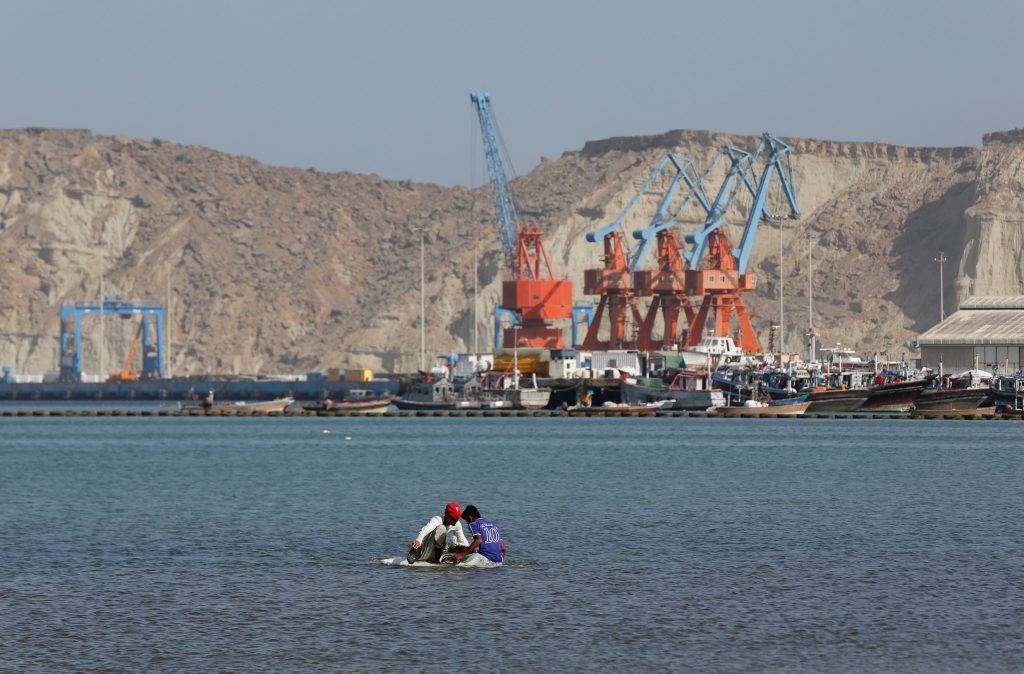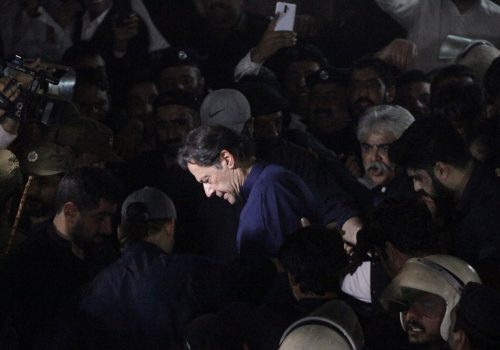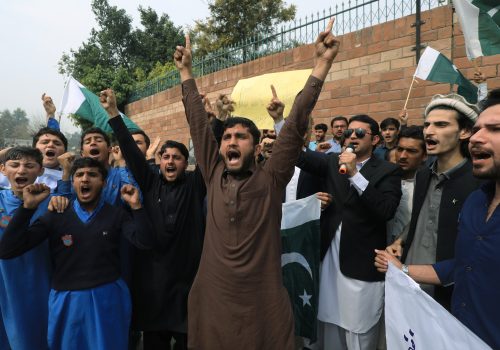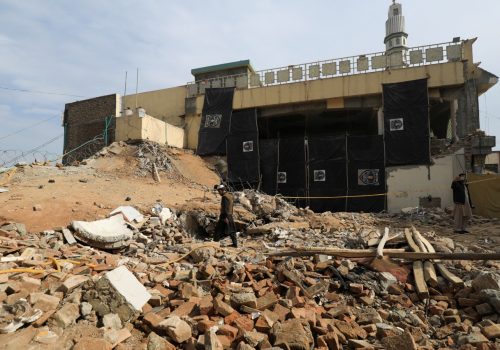The bilateral relationship between China and Pakistan dates back decades, and it has been characterized as a deep-rooted friendship critical to the long-term strategic interests of both countries. On Pakistan’s side, maintaining a strong relationship with China is at the heart of its foreign policy, most recently evidenced by the China-Pakistan Economic Corridor (CPEC) and ever-deepening military ties, as signified by the co-development of the JF-17 multirole combat aircraft.
The ongoing convergence of the economic, security, and political crises in Pakistan is having an impact on this strategic relationship. While the near-term impact of these crises has led to a slowdown in the execution of CPEC, the economic crisis in particular makes it likely for Pakistan to become even more reliant on Chinese support. This essay explores the potential impact of the ongoing crises on the China-Pakistan relationship and its implications for US-Pakistan bilateral relations, especially in the context of the growing strategic competition between the United States and China.
Increased dependency is the likely medium- and long-term outcome
In the midst of yet another economic crisis, Pakistan is currently facing significant upheaval in the political, economic, and security domains. Amplified by near-historic polarization among ruling elites, the rapidly deteriorating situation has significant implications on near- and long-term Chinese influence in the country.
The evolution of the crisis will determine the exact trajectory of this influence, but the following scenarios are likely to materialize in the near future:
- Increased concessions made to China to secure financial inflows. Even with the completion of the ninth review of the ongoing Extended Fund Facility (EFF) with the International Monetary Fund (IMF), Pakistan is going to continue facing significant balance of payments pressures. Almost 30 percent of the country’s external debt is owed to China and Chinese commercial banks; debt owed to China in the power sector is in addition to this figure. Negotiations to either ease conditions or access additional debt to ease the balance of payments crisis may lead to increased Chinese demands in the economic and security domains.
- Higher dependency on Chinese weapons to modernize the military and maintain strategic parity with India. Given the growing relationship between the United States and India, and Pakistan’s inability to meet its defense spending needs due to the economic crisis, it is likely that Islamabad becomes significantly more dependent on China in the coming years. This transition may accelerate in the nuclear and maritime domains in particular, with concessionary Chinese financing enabling Pakistan to procure advanced weapons systems considered critical for its national security interests. In addition, an acceleration of this trend is also likely to increase interoperability between Chinese and Pakistani military forces.
- Demands to deal with growing unrest in Gwadar due to economic exclusion. Higher rates of inflation are exacerbating the challenges faced by communities that have historically been on the periphery of Pakistan’s political economy. This includes the local community in Gwadar, where China has made significant investments to build a port and other related infrastructure. While weeks-long protests have been quashed in recent weeks, locals remain unhappy over lack of access to clean drinking water, loss of livelihood due to Chinese deep-water fishing, and limited access to jobs in key projects being undertaken in and around Gwadar.
- Presence of Chinese security to combat growing insurgent attacks on Chinese personnel and infrastructure. Recent months have seen a significant uptick in terror attacks across Pakistan, especially in Khyber-Pakhtunkhwa and Balochistan. The western corridor of the China-Pakistan Economic Corridor (CPEC) passes through this region, and both Baloch and Islamist militants have conducted a series of attacks targeting China. A sustained uptick in the tempo of these attacks may lead to increased demands for the presence of Chinese personnel to provide security to Chinese citizens and projects.
With its economy on the brink, Pakistan may make significant concessions to China to secure a large bailout package.
When it was first launched, CPEC was portrayed as a series of projects that would alter Pakistan’s developmental trajectory, generating new jobs, investment, and sustainable growth. While CPEC has managed to solve key infrastructure challenges for Pakistan, notably key among them being the chronic power shortages in the country, it has failed to deliver the type of sustainable growth many in Pakistan were expecting. Instead, the dollar-denominated debt taken on to finance large infrastructure projects has now saddled Pakistan’s economy, with economic experts suggesting that the country will likely require a debt restructuring in the coming months.
As of March 9, 2023, Pakistan is still engaged in talks with the IMF to complete the long-delayed ninth review of the ongoing EFF. Securing this agreement is vital to near-term economic stability and unlocking additional flows from friendly countries like China and Saudi Arabia. These inflows, however, are unlikely to bring long-term stability to the country given the scale of the near-term financing needs for the country.
This means that Pakistan will either have to engage with China for additional loans and deposits to build back its reserves, or engage in debt restructuring talks with both the Chinese and the Paris Club. In this scenario, China may demand additional concessions from Pakistan, including those that have long-term geopolitical ramifications. For example, during the crisis in Sri Lanka, China conducted a debt-to-equity swap for Hambantota Port, advancing the country’s geopolitical strategy in the Indian Ocean. In the Central Asian country of Tajikistan, similar agreements have been signed, including an October 2021 agreement to build a Chinese security facility in the country.
Local reports from key interlocutors in Pakistan suggest that China has previously made certain asks that Pakistanis have resisted, including a port call for a Chinese naval vessel at the Gwadar port. A rapidly deteriorating economy, with limited support from countries like the United States, is likely to increase Chinese leverage over Pakistan, forcing the latter to yield to Chinese requests that both expand Chinese influence in the Arabian Sea and also in the Himalayas, where the Chinese have built significant infrastructure to connect Gilgit-Baltistan to Xinjiang.
A reliance on geopolitical rents has created significant vulnerabilities.
Since its independence in 1947, Pakistan has found itself routinely at the door of the IMF. These bailouts are necessitated because policymakers pursue economic policies that generate unsustainable growth, leading to external sector crises where the country finds itself tapped out of foreign currency needed to repay its debt and fulfill import payment obligations.
Following the ouster of General Pervez Musharraf as president, successive democratically elected governments have required IMF bailouts, but only one in history has been successfully completed (in 2017, after which in 2018 Pakistan was already negotiating a new IMF program).
This stems from the failure of successive governments, both civilian and military, to restructure the economy away from benefiting a tiny elite at the expense of the welfare of ordinary citizens. These failures have not only created an unsustainable macroeconomic environment, forcing governments to seek bailouts from the IMF, but they also make strategic concessions to key allies and partners like the United States, China, and Saudi Arabia.
For example, a key driver of the cooperation provided to the United States in Afghanistan was the state of the economy in 2001. Once Pakistan decided to join forces with Washington, debt restructuring and an influx of dollars soon followed, leading to a short-lived economic boom that many Pakistanis still remember. A similar situation played out from 2013 onwards, when China decided to launch CPEC, the crown jewel of the Belt and Road Initiative. Inflows of foreign debt fueled economic growth, only for the country to find itself short on foreign currency needed to repay these obligations.
Successive IMF programs demand resolution of the same long standing issues. They also have the same impact on the broader economy: growth slows down, inflation rises, and millions of households fall below the poverty line.
The ongoing crisis, however, is significantly different both in terms of the scale of the crisis—Pakistan has only weeks of import cover left—and the fact that geopolitical rents are difficult to come by. In this situation, Pakistan has struggled to access additional funding from key allies, especially China.
However, should the crisis spiral out of control, Pakistan’s political and military elite are likely to accede to Chinese demands to stabilize the political economy. Should such an outcome materialize, Chinese influence in Pakistan, the Arabian Sea, and the Himalayas is likely to increase, leading to significant impact on the United States’ strategic interests in Central and South Asia as well as the Indian Ocean.
Economic pressures are likely to increase dependency on Chinese weapons, particularly in the nuclear and maritime domains.
While Pakistan has a historic defense partnership with China, its military has preferred weapons systems provided by Western countries, especially the United States. Over the last few years, however, a closer relationship between Washington and New Delhi has increased concerns in Rawalpindi, leading to an increased dependency on Chinese weapons. The economic crisis in Pakistan, if left unaddressed, will significantly accelerate Rawalpindi’s dependency on Chinese weapons, especially more expensive platforms considered critical to maintaining strategic parity with India.
Pakistan’s growing defense needs are likely to be met by cheaper Chinese weapons provided through concessional financing, as Islamabad finds it difficult to pay for modernization out of its own budget. Over time, such a transition is likely to reduce US influence in Pakistan, especially among the country’s powerful military establishment. As a result, Washington may find it difficult to have diplomatic and strategic leverage over Pakistan, given the declining reliance on US equipment on the one hand and growing defense ties between Washington and Delhi on the other.
As Pakistan’s dependence on Chinese systems grows, this cooperation is already accelerating interoperability between Chinese and Pakistani military forces.
Increased militarization of Gwadar due to local protests may deepen the Chinese military influence in the port city.
Chinese investments in Gwadar have led to a growing sense of isolation and exclusion among the local communities in the city. This has turned into a political crisis, with local leaders conducting a series of protests in early 2023. Key demands from the protestors have revolved around access to clean water and electricity, investments in the local community, and provision of jobs and protection of livelihoods for fishermen from deep-sea trawlers, many of which are Chinese.
In 2022, the Haq Do Tehreek (Gwadar Rights Movement) staged sit-in protests for over fifty days in Gwadar, including outside the main entrance to the port. They “blocked the Gwadar East Bay Expressway” and conducted protests “outside the under-construction New Gwadar International Airport.” In addition, the protestors demanded that the Chinese leave the city.
Succumbing to Chinese pressure, Pakistani officials acted aggressively to deal with the protests, arresting the movement’s leader and imposing emergency law in the city to prevent a worsening of the situation. These actions have only further angered the local community, risking further protests and violent actions in Gwadar. Most recently, Pakistan’s army chief visited the port city, blaming a “handful of misguided elements” for the worsening situation.
The continuation of these tensions are likely to further militarize Gwadar in the coming months, especially due to a deteriorating political and economic environment. This is likely to not only lead to increased presence of the Pakistani military in the area, but also increased demands by the Chinese to allow their own security personnel—private contractors and others—in the area to guard key facilities.
A worsening security situation may also lead to a growing presence of Chinese security personnel across Pakistan.
Recent weeks have also seen an increase in the tempo of militant attacks carried out by both Baloch and Islamist militant groups, including the Baloch Liberation Army (BLA) and the Tehreek-e-Taliban Pakistan (TTP). Recognizing the growing discontent among Baloch, the TTP has also started to target Baloch youth in its information operations, arguing that they have the same enemy.
As a result, a sustained uptick in attacks on Chinese engineers, teachers, and facilities has been witnessed in recent months, including a suicide bombing that killed Chinese language teachers in Karachi. The growing security concerns have led Chinese officials to demand increased security measures from Pakistan and reportedly some conversations about providing permits to Chinese security personnel to provide security details to Chinese officials and facilities in Pakistan. While Pakistan has so far resisted these demands, a worsening economic and security situation is likely to increase Chinese pressure. Pakistan will find it challenging to resist these demands in a scenario where US support to counter militant groups is limited, especially if China makes these demands as part of a broader economic and security assistance package to stabilize the country’s economy.
Indifference from the United States will accelerate these trends.
The ongoing crisis in Pakistan is perhaps the most serious threat to national cohesion since the war in 1971, which culminated in the surrender at Dhaka and the birth of Bangladesh. With Pakistan’s economy on the brink of default, groups such as the TTP and BLA are sensing a weakness, leading to a rapid uptick in their attacks on Pakistani security personnel. In addition, these groups have selectively targeted Chinese personnel and key CPEC projects to further undermine domestic and international confidence in the country’s ability to deal with these challenges.
As these crises metastasize, Islamabad is likely to engage both the United States and China for additional support. With the former signaling a largely cold indifference to Pakistan in these trying times, Pakistan has sought support from both China and Saudi Arabia. These allies have, for the time being, asked Islamabad to engage with the IMF and bring the EFF back on track. However, they have also indicated that they will not let Pakistan descend into a chaotic and disorderly default akin to what Sri Lanka experienced several months ago. This makes it all the more likely that as the economic and security crisis worsens, China will retable some key security and geopolitical demands in discussions with Pakistani officials.
Should the crisis reach a point of no return for Pakistan, its leaders may accede to Chinese demands, leading to a dramatic increase in Beijing’s influence in the region, including the Arabian Sea, the Himalayas, and onwards into Afghanistan and Central Asia.
Given this context, it is vital for the United States to consider the implications of the possible scenarios laid out above and perhaps seek to develop a more robust strategy that prevents (or at the very least slows down) Pakistan from becoming a major Chinese outpost in Southwest Asia and the Indian Ocean basin regions.
Uzair Younus is director of the Pakistan Initiative at the Atlantic Council’s South Asia Center. He also is the Vice President at The Asia Group.

The South Asia Center is the hub for the Atlantic Council’s analysis of the political, social, geographical, and cultural diversity of the region. At the intersection of South Asia and its geopolitics, SAC cultivates dialogue to shape policy and forge ties between the region and the global community.
Related content
Image: Boys sit on a piece of styrofoam sheet as they search for crabs in front of the Gwadar port, Pakistan April 11, 2017. REUTERS/Akhtar Soomro



